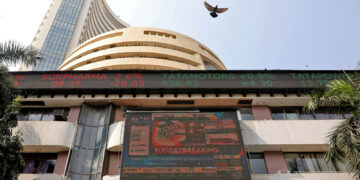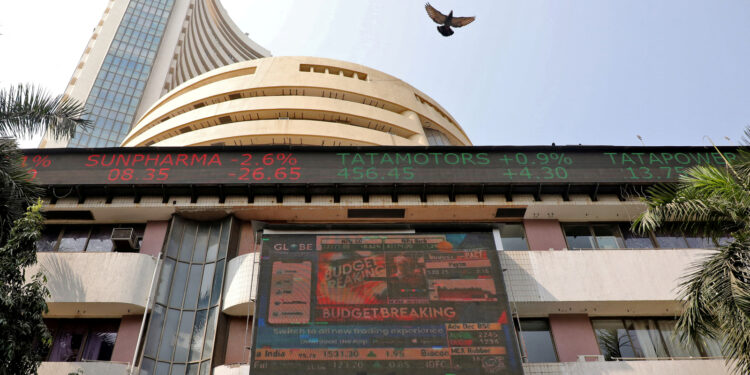The Indian stock market opened in the green amid the global uncertainties due to the ongoing US-China trade war. At 9:15 am, the BSE benchmark Sensex was up by more than 1,000 points and trading at 74,942.46
At 9:15 am, the BSE benchmark Sensex was up by more than 1,000 points and trading at 74,942.46. The NSE Nifty was trading at 22,746.40, up by 347.25 points from the previous close.
The Indian stock market closed in the red today, with both benchmark indices witnessing a decline. The BSE Sensex slipped 379.93 points, or 0.51%, to settle at 73,847.15. Meanwhile, the NSE Nifty fell 136.70 points, or 0.61%, ending the session at 22,399.15.
Among the Sensex constituents, State Bank of India (SBI) recorded the sharpest fall, declining by 3.43% to trade at ₹742.05. Tech Mahindra also saw a notable drop of 3.25%, closing at ₹1,272.20.
On the brighter side, Larsen & Toubro (L&T) emerged as a top gainer, rising 3.23% to close at ₹3,059.10.
In today’s market session, 12 out of the 30 Sensex stocks managed to close in the green, showing selective strength amidst broader weakness.
On the sectoral front, the Nifty PSU Bank Index saw the sharpest decline, falling by 2.52% to settle at 6,092.55. This was followed by the Nifty IT Index, which dropped 2.19% to 32,517.35, and the Nifty Pharma Index, which declined by 1.97% to close at 19,976.30.

Top Sensex Losers on Wednesday:
On Wednesday, the Indian stock market saw a mixed trend among the Sensex constituents. Among the 30 Sensex stocks, State Bank of India (SBI) emerged as the top loser, with its shares falling by 3.43%, closing at ₹742.05.
Tech Mahindra followed closely, witnessing a 3.25% decline to settle at ₹1,272.20. Interestingly, Larsen & Toubro (L&T), despite being listed among the top movers, ended the day on a positive note with a 3.23% gain, trading at ₹3,059.10.
Overall, 12 out of the 30 Sensex stocks ended the day in the green, indicating selective buying amid broader market fluctuations.
In today’s market session, sectoral indices witnessed a downturn across the board. Leading the decline was the Nifty PSU Bank Index, which dropped by 2.52%, settling at 6,092.55. Following closely, the Nifty IT Index recorded a 2.19% fall to close at 32,517.35. Meanwhile, the Nifty Pharma Index also saw a notable dip of 1.97%, ending the day at 19,976.30.
Foreign Institutional Investors (FIIs) continued their selling spree, offloading equities worth ₹4,358.02 crore in the latest trading session. In contrast, Domestic Institutional Investors (DIIs) remained optimistic, purchasing equities to the tune of ₹2,976.66 crore, indicating a divergence in sentiment between global and local market participants.
On the debt side, the benchmark 10-year India Government Bond witnessed a modest gain of 0.24%, or ₹0.25, pushing its price up to ₹102.46.
Akshay Chinchalkar, Head of Research at Axis Securities, commented on the market outlook, stating, “The Nifty is expected to open around the 22,800 – 22,900 range. However, the key will be whether the index can maintain upward momentum. The psychological level of 23,000 stands as an initial resistance, followed by the critical 23,000 – 23,500 zone, where both the 50-day and 100-day moving averages are currently acting as hurdles.”
Investors are advised to keep a close watch on global cues and domestic earnings reports as market volatility may persist in the near term.
Trump tariff live updates: US’ pause on tariffs brings respite to Indian Stock markets
Trump tariff live updates: The US threatened Mexico with sanctions and tariffs over a water dispute, accusing the latter of violating an 81-year-old treaty between the countries.
The ongoing tensions between the United States and China have erupted into a full-scale trade war, with neither side showing signs of retreat. On April 2, US President Donald Trump unveiled a sweeping tariff plan, introducing a 10% base tariff on nearly all imports into the United States. Additionally, reciprocal tariffs targeting products from over 60 countries—including China and India—were announced as part of a broader strategy to reshape global trade in America’s favor. This aggressive move marks a significant escalation in the US’ efforts to protect domestic industries and reduce its trade deficit.
In response to the recent sharp downturn in global markets, the United States announced on Wednesday a 90-day suspension of additional reciprocal tariffs on all nations—excluding China. Despite the pause, the base tariff rate of 10% will continue to apply across the board.
This move follows an extended series of escalating trade measures between the US and China. As it stands, China is now facing cumulative tariffs of up to 145%, resulting from continued tariff hikes by the US. This development was triggered after China implemented an 84% tariff on US imports, a decision that officially took effect on Thursday.
The trade tensions between the two economic powerhouses continue to influence global supply chains and investor sentiment, with analysts closely watching the impact of these policies in the coming weeks.
Read Also
IPL 2025 Points Table: DC Remain Unbeaten, Join GT at the Top – RCB & PBKS Not Far Behind!















 Categories
Categories









